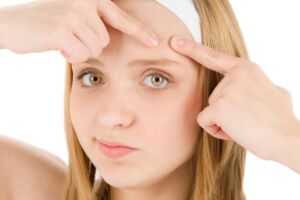What is Acne?
Acne Treatment & Prevention : Acne is the most frequent skin condition in the United States. It is characterized by pimples that appear on the face, back and chest. Every year, about 80% of adolescents have some form of acne and about 5% of adults experience acne. Acne is made up of two types of blemishes:
- Whiteheads/Blackheads, also known as comedones, are non-inflammatory and appear more on the face and shoulders. As long as they remain uninfected, they are unlikely to lead to scarring.
- Red Pustules or Papules are inflamed pores that fill with pus. These can lead to scarring.
Acne is a skin condition with blackheads, whiteheads, red pimples, and cysts. It usually affects the face, but can also involve the upper body. Acne affects people of all ages and in some, can leave dark marks or pitted scars. The most common acne trigger is hormonal changes that teenagers experience during puberty and adults usually experience during stressful periods. Hormonal acne appears in the form of deep, cystic blemishes around the chin, neck, and back.
Acne in teenagers is caused by the hormone testosterone, which increases during puberty and stimulates sebaceous glands of the skin to grow, make oil and plug pores. In adults, acne may be related to hormones, stress, childbirth, menopause, or medications. Diet, specifically certain dairy products and high-glycemic-index foods may exacerbate acne in some patients.
What Causes Acne?Â
In normal skin, oil glands under the skin, known as sebaceous glands, produce an oily substance called sebum. The sebum moves from the bottom to the top of each hair follicle and then spills out onto the surface of the skin, taking with it sloughed-off skin cells.
With acne, the structure through which the sebum flows gets plugged up. This blockage traps sebum and sloughed-off cells below the skin, preventing them from being released onto the skin’s surface. If the pore’s opening is fully blocked, this produces a whitehead. If the pore’s opening is open, this produces blackheads. When either a whitehead or blackhead becomes inflamed, they can become red pustules or papules. It is important for patients not to pick or scratch at individual lesions because it can make them inflamed and can lead to long-term scarring.
How to Prevent Acne
In general, if you are prone to acne, you should wash your face with a mild cleanser and warm water daily. Washing too much or too vigorously can make acne worse. Any products used on the skin should say “non-comedogenic†on the bottle. This means they do not contain pore-clogging ingredients.
How to Treat Acne
Treatment for mild acne starts with topical antibiotics, retinoids (vitamin A based topicals), anti-inflammatory agents and benzoyl peroxide. Cortisone injections may be utilized to rapidly shrink cystic lesions (same day appointments available when needed).
Acne surgery may be performed to extract black and whiteheads. In more severe cases, antibiotic pills are often prescribed. In some women, hormonal treatments may also be recommended. If your acne doesn’t respond or is extremely severe and scarring, oral isotretinoin may be utilized. Treating acne is a relatively slow process; there is no overnight remedy. Some treatments include:
- Benzoyl Peroxide: Used in mild cases of acne, benzoyl peroxide reduces the blockages in the hair follicles.
- Oral and Topical Antibiotics:Â Used to treat any infection in the pores.
- Hormonal Treatments:Â Can be used for adult women with hormonally induced acne.
- Tretinoin:Â A derivative of Vitamin A, tretinoin helps unplug the blocked-up material in whiteheads/blackheads. It has become a mainstay in the treatment of acne.
- Extraction:Â Removal of whiteheads and blackheads using a small metal instrument that is centered on the comedone and pushed down, extruding the blocked pore.
For those who wish to avoid taking medications, Affiliated Dermatology offers alternatives for acne treatment such as microneedling and chemical peels.
Chemical Peels for Acne
Chemical peels are an excellent way to bring back the smooth texture of your skin. We offer many different treatments such as light, medium, or heavy depth chemical peels for various skin types. The people who come in for our chemical peels are usually suffering from acne, extensive sun damage, or just want a rejuvenated appearance. Our chemical peel treatments have also been known to cut down on precancerous lesions that may lead to the development of skin cancer.
- Sensi Peel
- Ultra Peel
- PCA Peel
- Ultra Peel Forte
- 6% Retinol Peel
Microneedling for Acne and Acne ScarringÂ
The SkinPen utilizes fine needles is used to create “micro-tunnels†of the skin. These microscopic wounds stimulate the skin’s natural healing process which increases collagen and elastin production. Microneedling breaks up scar tissue, plumps acne scarring, reduces pore size and improves skin texture. Acne targeting medications are applied at the start of the procedure and driven into target areas by the instrument to increase effectiveness. The depth of penetrated medication enhances results to give you the results you’ve been hoping for.

